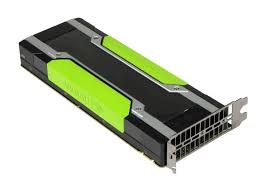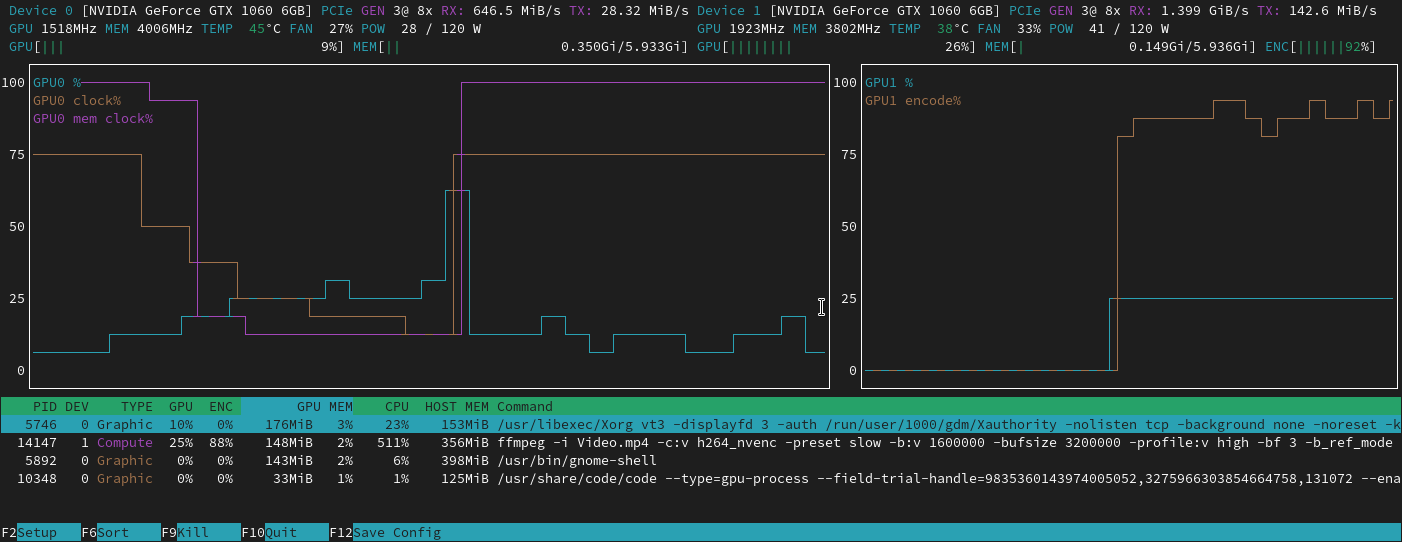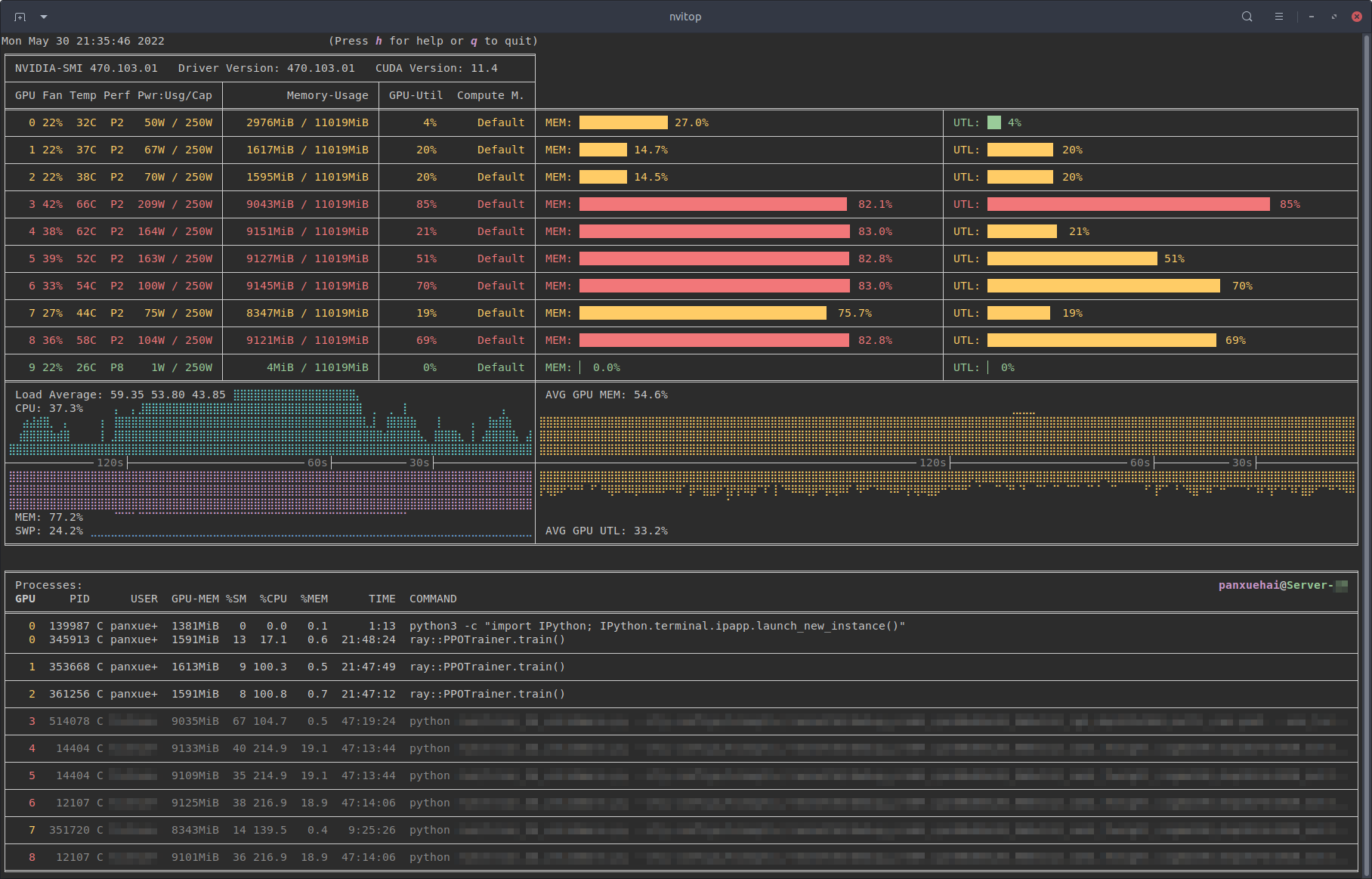Using GPUs¶
The ddg and sbg nodes contain GPU cards that can provide huge acceleration for certain types of parallel computing tasks, via the CUDA and OpenCL frameworks.
Access to GPU nodes
Access to GPU nodes is available for free to QM Researchers. Please test your job on the short queue and check that the GPU is being used, then contact us to request addition to the allowed user list in order to use the GPU nodes fully. Note that access to GPU nodes is not permitted for Undergraduate and MSc students, or external users.
Short queue GPU testing
QM Researchers should test their GPU code on the 1-hour short queue before
requesting full GPU node access for the first time. Please provide
supporting evidence of a working GPU job (a job id, or screenshot of
nvidia-smi output) when requesting node access - see below for more
information and examples.
Applications with GPU support¶
There are a
considerable number of
scientific and analytical applications with GPU support. While some have GPU
support out of the box, such as Matlab and
Ansys, others may require specific GPU-ready
builds. These may appear in the module avail list with a -gpu suffix. If
you require GPU support adding to a specific application, please
submit a request for a GPU build and provide some test
data.
Be aware that not every GPU-capable application will run faster on a GPU. For example, an application may only have specific subroutines that offer GPU acceleration - code that is not GPU aware will instead run on the CPU.
Submitting jobs to GPU nodes¶
To request a GPU, the -l gpu=<count> option should be used in your job
submission. Jobs must request 8 cores per GPU (-pe smp 8) and 11GB RAM per
core (-l h_vmem=11G) to ensure the number of cores and RAM requested is
proportionate to the number of GPUs requested
(please see the examples below).
The scheduler will automatically select a GPU node based on availability and
other resource parameters, if specified.
For users with access to nodes that have 48 cores or more, you may request 12
cores per GPU to better utilise the available resources. To request 12 cores
per GPU, please change your RAM request to -l h_vmem=7.5G (eligible GPU high
memory jobs may request up to 20G RAM per core with 12 core jobs) and ensure
your job includes one of the following parameters:
-l cluster=andrena(Andrena cluster users only)-l node_type=Xwhere X is one of:ddg,rdgorxdg. (Note: RDG and XDG nodes are available only to users from the Science and Engineering faculty.)-l gpuhighmem(For Science and Engineering faculty users only). This parameter is equivalent to-l node_type=rdg|xdgon the S&E nodes.
Failure to add one of these parameters will result in the job being rejected.
We have also enabled the short queue on all GPU node types which may be used before acquiring access to run longer GPU jobs. Jobs submitted to the short queue have a higher priority than main queue jobs and will run as soon as the node becomes free and no other jobs are running in the main queue.
Selecting a specific GPU type¶
For compatibility, you may optionally require a specific GPU type. Nodes with
the Volta V100 GPU may be selected with -l gpu_type=volta, and
Ampere A100 nodes may be selected with -l gpu_type=ampere.
GPU card allocation¶
Do not set the CUDA_VISIBLE_DEVICES variable
For reasons documented below, please do not set the CUDA_VISIBLE_DEVICES
variable in your job scripts.
We have enabled GPU device cgroups (Linux Control Groups) across all GPU nodes on Apocrita, which means your job will only be presented the GPU cards which have been allocated by the scheduler, to prevent some applications from attaching to GPUs which have not been allocated to the job.
Previously, it was required to set the CUDA_VISIBLE_DEVICES variable in job
scripts to ensure the correct GPU is used in the job. However, this was a
workaround until the GPU device cgroups were applied. You should no longer
set this variable in your job scripts.
Inside your job, the GPU cards presented to your job will always appear as device 0 to device N, depending on how many GPU cards you have requested. Below demonstrates the devices presented to jobs, per GPU resources request:
| GPUs Requested | Devices Presented |
|---|---|
| 1 | 0 |
| 2 | 0, 1 |
| 3 | 0 - 2 |
| 4 | 0 - 3 |
Checking GPU usage¶
Never execute compute via direct SSH
All jobs must be submitted via the queueing system. Executing code via a direct SSH connection to a compute node is a serious breach of our Usage Policy and will result in account suspension. SSH connections are provided for monitoring only.
The monitoring tools below need to be run directly on the nodes allocated to
your jobs. You will need to login directly to the node from an existing login
node session via SSH (e.g. ssh sbg1 - if prompted for a password, use your
standard Apocrita password).
Errors such as:
-bash: nvidia-smi: command not found
indicate that your are probably still on a login node.
You can establish which nodes have been allocated to your jobs using the
qstat command, or by
referring to the Open OnDemand card for your jobs shown in the
"My Interactive Sessions" section.
When you SSH directly into a node, you will see the following warning, please do not ignore it:
--------------------------------------------------------------------------------
| ****You are directly logged into a compute node, DO NOT start jobs here**** |
| |
| All jobs MUST be run via the queuing system. It is permissible to log |
| directly into the compute nodes only to check on the state of a job but |
| actual compute work MUST NOT be started in this way. |
| |
| Starting jobs directly via SSH will result in account suspension. |
| |
| The only allowed commands are: lsof, top, ps, pstree, strace, nvidia-smi, |
| nvtop or nvitop. Any other commands must be explicitly authorised by ITS |
| Research prior to use. |
--------------------------------------------------------------------------------
Checking GPU usage with nvidia-smi¶
GPU usage can be checked with the nvidia-smi command e.g.:
$ nvidia-smi -l 1
|-------------------------------+----------------------+----------------------+
| GPU Name Persistence-M| Bus-Id Disp.A | Volatile Uncorr. ECC |
| Fan Temp Perf Pwr:Usage/Cap| Memory-Usage | GPU-Util Compute M. |
| | | MIG M. |
|===============================+======================+======================|
| 0 Tesla V100-PCIE... On | 00000000:06:00.0 Off | 0 |
| N/A 70C P0 223W / 250W | 12921MiB / 16160MiB | 97% Default |
| | | N/A |
+-------------------------------+----------------------+----------------------+
| 1 Tesla V100-PCIE... On | 00000000:2F:00.0 Off | 0 |
| N/A 30C P0 23W / 250W | 4MiB / 32510MiB | 0% Default |
| | | N/A |
+-------------------------------+----------------------+----------------------+
| 2 Tesla V100-PCIE... On | 00000000:86:00.0 Off | 0 |
| N/A 30C P0 23W / 250W | 6MiB / 32510MiB | 0% Default |
| | | N/A |
+-------------------------------+----------------------+----------------------+
| 3 Tesla V100-PCIE... On | 00000000:D8:00.0 Off | 0 |
| N/A 31C P0 23W / 250W | 6MiB / 32510MiB | 0% Default |
| | | N/A |
+-------------------------------+----------------------+----------------------+
+-----------------------------------------------------------------------------+
| Processes: |
| GPU GI CI PID Type Process name GPU Memory |
| ID ID Usage |
|=============================================================================|
| 0 N/A N/A 1557 C python 12915MiB |
+-----------------------------------------------------------------------------+
In this example we can see that the process is using GPU 0. We use the -l 1
option which tells nvidia-smi to repeatedly output the status. Should this
be run inside a job, GPU 0 would be the card you have been allocated, which
might not be system device 0.
If you SSH into a GPU node and run nvidia-smi, you will see all system
GPU devices by their real ID, rather than the allocated device number.
Similarly, the SGE_HGR_gpu environment variable inside jobs and the
qstat -j JOB_ID command will also show the actual GPU device granted.
Checking GPU usage with gpu-usage¶
Another tool to check your GPU job is gpu-usage:
$ gpu-usage
--------------------
Hostname: sbg2
Fri 17 Jun 14:36:03 BST 2022
Free GPU: 2 of 4
--------------------
GPU0: User: abc123 Process: gmx Utilization: 53%
GPU1: User: bcd234 Process: python Utilization: 78%
GPU2: Not in use.
GPU3: Not in use.
User: abc123 JobID: 2345677 GPU Allocation: 1 Queue: all.q
User: bcd234 JobID: 2345678 GPU Allocation: 1 Queue: all.q
User: cde345 JobID: 2345679 GPU Allocation: 1 Queue: all.q
Warning! GPUs requested but not used!
In this example, we can see that two jobs (2345677 and 2345678) are correctly
using the GPUs. The third job (2345679) from user cde345 has requested a
GPU but is not using it.
Checking GPU usage with nvtop and nvitop¶
Two other tools to check your GPU job are nvtop and nvitop. They are both
available in a module called nvtools:
module load nvtools
To run nvtop:
nvtop
nvtop provides a colourised view of GPU activity on a node, in a similar
layout to the popular htop system monitor. More information can be found in
its
documentation.
To run nvitop:
nvitop
nvitop also provides a colourised view of GPU activity on a node, with a
slightly alternative layout compared with nvtop. Press h for help or q to
return to the terminal. nvitop has a lot
of powerful options which can be explored in its
documentation.
Example job submissions¶
The following examples show the basic outline of job scripts for GPU nodes. Whilst the general rule for compute nodes is to strictly request only the cores and RAM you will be using, our GPU jobs are GPU-centric, so requests should focus around the number of GPUs required.
For simplicity, GPU jobs must request 8 cores per GPU, and 11GB RAM per core, as shown in our examples below and other documentation pages (for example TensorFlow). Whilst it is possible for some users to request 12 cores per GPU by requesting extra resources, we have not provided a generic example for that here. Please refer to other documentation pages on this site for more information.
h_vmem does not need to account for GPU RAM
The h_vmem request only refers to the system RAM, and does not need to
account for GPU RAM used. The full GPU RAM is automatically granted when
you request a GPU
requesting exclusive access
Requesting exclusive access on the GPU nodes will block other GPU jobs from starting. Please only request exclusive access if also requesting the maximum number of GPUs available in a single GPU node and your code supports multiple GPUs.
Short Queue Testing¶
Request one short queue GPU¶
#!/bin/bash
#$ -cwd
#$ -j y
#$ -pe smp 8 # 8 cores (8 cores per GPU)
#$ -l h_rt=1:0:0 # 1 hour runtime (required to run on the short queue)
#$ -l h_vmem=11G # 11 * 8 = 88G total RAM
#$ -l gpu=1 # request 1 GPU
./run_code.sh
Request two short queue GPUs¶
#!/bin/bash
#$ -cwd
#$ -j y
#$ -pe smp 16 # 16 cores (8 cores per GPU)
#$ -l h_rt=1:0:0 # 1 hour runtime (required to run on the short queue)
#$ -l h_vmem=11G # 11 * 16 = 176G total RAM
#$ -l gpu=2 # request 2 GPUs
./run_code.sh
Request four short queue GPUs (whole node)¶
#!/bin/bash
#$ -cwd
#$ -j y
#$ -pe smp 32 # 32 cores (8 cores per GPU)
#$ -l h_rt=1:0:0 # 1 hour runtime (required to run on the short queue)
#$ -l gpu=4 # request 4 GPUs
#$ -l exclusive # request exclusive access
./run_code.sh
Production GPU Nodes¶
Request one GPU¶
#!/bin/bash
#$ -cwd
#$ -j y
#$ -pe smp 8 # 8 cores (8 cores per GPU)
#$ -l h_rt=240:0:0 # 240 hours runtime
#$ -l h_vmem=11G # 11 * 8 = 88G total RAM
#$ -l gpu=1 # request 1 GPU
./run_code.sh
If requesting exclusive access on a node with 1 GPU card installed
(DDG nodes), please also specify the node type with the
#$ -l node_type=ddg parameter to avoid requesting exclusive access on a
node with 4 GPU cards, otherwise your job may queue for a very long time.
Request two GPUs¶
#!/bin/bash
#$ -cwd
#$ -j y
#$ -pe smp 16 # 16 cores (8 cores per GPU)
#$ -l h_rt=240:0:0 # 240 hours runtime
#$ -l h_vmem=11G # 11 * 16 = 176G total RAM
#$ -l gpu=2 # request 2 GPUs
./run_code.sh
Request four GPUs (whole node)¶
#!/bin/bash
#$ -cwd
#$ -j y
#$ -pe smp 32 # 32 cores (8 cores per GPU)
#$ -l h_rt=240:0:0 # 240 hours runtime
#$ -l gpu=4 # request 4 GPUs
#$ -l exclusive # request exclusive access
./run_code.sh
If you are requesting all GPUs on a node, then choosing exclusive mode will give you access to all of the resources. Note that requesting a whole node will likely result in a long queueing time, unless you have access to an "owned" GPU node that your research group has purchased.
Submitting jobs to an owned node¶
If your research group has purchased a GPU node, the scheduler default action will be to firstly check for available slots on owned node(s), and then the public GPU nodes (if applicable). If you want to restrict your job to your owned nodes only (e.g. for performance, or to ensure consistency), then adding:
#$ -l owned
to the resource request section at the top of your job script will restrict the job to running on owned nodes only.
Getting help¶
If you are unsure about how to configure your GPU jobs, please contact us for assistance.


